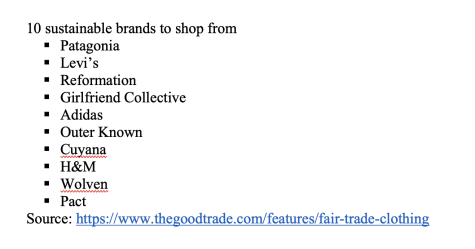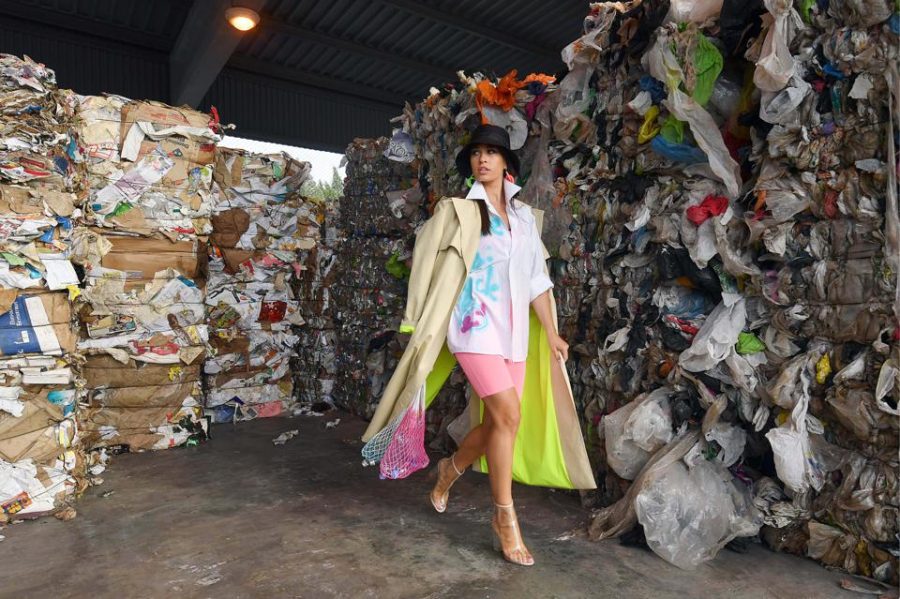Fast Fashion Vs. Our Planet
https://www.forbes.com/sites/andriacheng/2019/08/23/major-fashion-companies-sign-pact-vowing-to-reduce-industrys-environmental-impact/?sh=1789c7b24db1
October 6, 2022
History repeats itself, especially in fashion. Y2K-inspired miniskirts, flared jeans, Bob Ross artsy aesthetic are all examples of trends that have been circulating the web and social media. Influencers and followers are in a constant race with keeping up with these trends resulting in fast fashion, cheap products, and the frequent purchase of clothing. While these purchases can make our closets fuller and up to date, it’s costing us our environment and welfare.
Trends and social media influence the mass production of clothing around the world to push out millions of pieces of clothing a year and fast. “Mass Production Disadvantages,” an article posted on Boycewire.com, a site to educate people about key principles of economics and societal issues, defines mass production as “the making of products in large quantities so that businesses can sell them to the masses.” The amount of clothes that are being pumped through companies in such large quantities is because of fast fashion; mass production and fast fashion coincide.
Fast fashion’s designs, looks, and ideas come from runways and fashion shows. On the website WallStreetJournal.com, the article titled “The High Price of Fast Fashion” states, “Guests lining the runways upload photos and video clips on social media, and fast fashion design teams…note the number of likes and choose which ones they want to steal and produce for pennies apiece.” In other words, fast fashion aims to make stylish clothes affordable, attainable, and quick enough in the shopping carts of consumers who are influenced by vogue on social media.
Mass production and fast fashion have not only polluted the minds of people on social media, but our Earth as well. When you throw away garbage, the idea is that the trash is being thrown out. Realistically trash sits on our earth until it breaks down, if it ever does.
Many clothes produced in big quantities sold at cheap prices are made from synthetic materials and dyes that won’t biodegrade in landfills. EcoWatch.com, an environmental newspaper, posted an article titled “Fast Fashion: Cheap Clothes= Huge Environmental Cost” which reveals that in about two decades, clothes that were trashed amounted to 14 million tons, about 80 pounds of clothes per person. Fast fashion is climbing up the dirtiest global industry ladder, being second after oil.
When clicking on crop tops and artsy jeans sold at 15 dollars on Shein, these pieces are actually made for cents per piece, in horrible working conditions, by overworked and underage workers. However, for many poor countries, the production of these garments saves the people from “extreme poverty.” The World Bank’s International Finance corporation in a fact sheet called “Building a sustainable textile and apparel Market in Bangladesh,” explains the country’s $28 billion fashion industry is crucial to its economy, employing about 4.5 million people and children in Bangladesh.
Catching up with trends and buying single-use pieces for the perfect Instagram post is making it difficult to break the cycle. Some ways people can shop sustainably is buying secondhand clothes in shops like Goodwill, Salvation Army, or your local thrift stores, as well as from online apps such as Poshmark, Mercari, and Vintage. Buying timeless and good quality clothes will be essential in your closet and for your pocket. Besides, the price of our Earth’s environment is worth more than temporary happiness from a 3 dollar tank top.







Oscar • Oct 10, 2022 at 2:17 pm
Great article! So sad how fast fashion has taken over nowadays.
Abrianna • Oct 10, 2022 at 12:48 pm
I loved it!!! Very well detailed.. it was amazing all around.
Jan • Oct 10, 2022 at 12:29 pm
Amazing Article!!!!